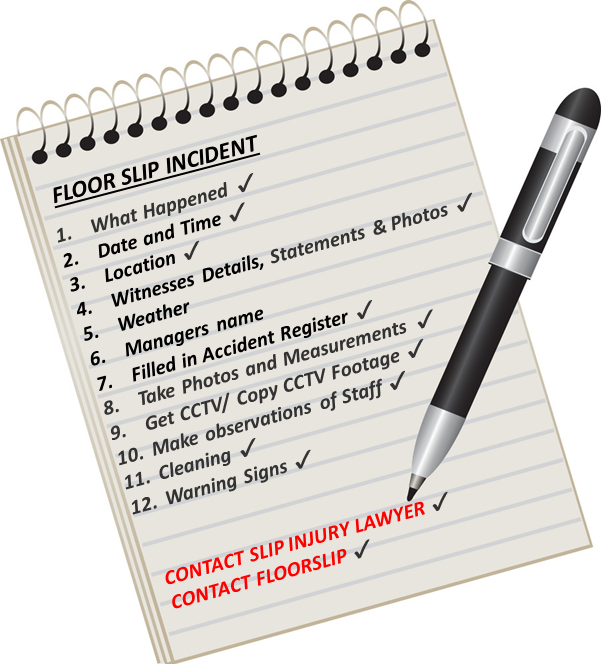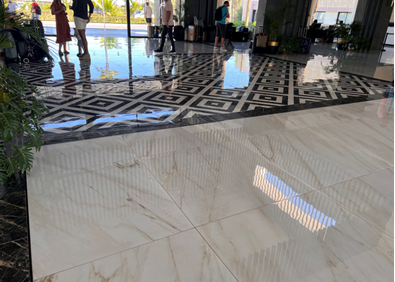I have slipped...Help me claim.
Have you, friend, family member or colleague slipped, tripped or fallen on a floor which resulted in a Slip Injury?
It is more than likely you can claim for damages and win in a high majority of cases. It has been our experience over the past 12 years of preparing Expert Witness Reports on behalf of Slip Injury Lawyers (both in the UK and abroad) that in the majority of cases, the floor surface was not suitable for task or not managed / controlled adequately (or both).
Laws on Floors
There are Laws on Floors in the UK, which must be complied with. It has been our experience though that for most cases where a floor slip or trip injury claim is required, the owner or manager of that floor will have failed to meet the laws or even the intent of the laws.
The next section will help you as Claimant / Pursuer or Defendant / Defender to determine what to do. As you read through this next section – grab a paper and pen and make some notes
The chances are the company or organisation that allowed you to slip have failed to follow the practices (discussed further down) in which case you probably have a very good case – Contact one of the Slip Injury Lawyers in the page dedicated for this purpose (link shown above) or Contact FloorSlip and we will talk you through the next steps.

Checklist of items to do Straightaway in a Slip Injury Accident Claim
1. ACCIDENT REGISTER - Always get an entry made in the Accident Register; take a photo of the entry (sometimes they mysteriously disappear!). If they don’t have an accident register then write down on paper there and then what happened and ask the company person to sign it making sure to get their name, position and date and any witness names and contact details.
2. WRITE DOWN WHAT HAPPENED IMMEDIATELY - Record for safety what happened, why, when, how, the time, date etc. You will forget over time and some court cases can take a long time to get to court.
3. TAKE PHOTOS OF THE SCENE Either at the time of the event or as soon as possible afterwards
4. TAKE MEASUREMENTS For example, how far is paces from the external doors or from a source of contaminants like a kitchen or bathroom
5. GET WITNESS NAMES AND CONTACT DETAILS – Ideally contact them as soon as possible after the event to write down a small statement of events. See if they captured any photos.
6. CCTV Most companies now have CCTV, ask to see and get a copy as soon as possible. Take a recording on your phone camera if possible (CCTV footage also has a tendency to mysteriously disappear or be wiped over!)
7. OBSERVATIONS – As soon as possible after the incident (day or two), go back to the area of slip and trip and discretely observe for some time. Consider how many staff there are, how often they are present in the position where the slip, trip or fall occurred. Do you see any cleaning going on? Is cleaning equipment available? Are two-way communications used like walky-talky’s / phones? Look for warning / caution signs; take photos of those you see (or don’t see!). Signs and warnings tend to miraculously appear after slip events! Note that signs are generally only useful for example, where a spill has occurred and a warning sign is placed there; but should not be the norm, a safe floor should be the norm.
8. FINALLY, in respect to all the rest spoken about on this page (such as getting copies of Risk Assessments) we suggest you leave to your Slip Injury Lawyer whom will typically contact FloorSlip (or other floor testers) for us to conduct an on-site assessment and Floor Pendulum Test and provide a UK Court Compliant Expert Witness Report (Known as a CPR in England). The Slip Injury Accident Lawyer will also request all the other paraphernalia like CCTV, Historic Floor Tests, Flooring Specifications and such like.
These are the typical breaches of floor safety protocol
Item 1 – FAILURE TO PENDULUM TEST
Either on building handover or as part of annual risk assessments to determine its slip resistance, a Floor Pendulum Test is a definiet requirement becuase there is no other way tio assess the Floor Slip Resistance.
A floor which will become WET or CONTAMINATED with minimal chance to clean or prevent the water / contaminants, must have a floor that will provide a 36 PTV (Pendulum Test Value) when tested in the WET and CONTAMINATED states. The UK HSE regards the value of 36 PTV (where 0 is the worst value) as the minimum necessary to maintain a safe floor with a Low Probability of Slip and that value must be adjusted upwards for Floor Slopes (1.75 PTV for every 1 degree of slope).
Floor Contaminant Examples might be...
- Environmentally WET Contaminants such as Rain, Snow, Fog, Dew. Particularly important is environmental contaminants that get walked in on shoes or drip from coats, bags, umbrellas etc. which can spread many metres onto a floor surface.
- Local Wet Contaminants such as Jacuzzis, showers, swimming pools, water from cut flowers, spilt liquids in a supermarket or other more viscous contaminants such as Oil, Paint, Fat,
- Local Dry Contaminants such as sawdust, swarf, talcum powder, and foot powder
Item 2 – FAILURE TO CONDUCT RISK ASSESSMENTS or Conducting inadequate assessment / partial assessments / Self Assessing / Failure to follow up on Risks raised / Using generic statements
The largest risk to life and limb in injury and death are: -
- Falls – Not just from Height but on stairs or around the home and workplace
- Slips / Trips and Falls on Floors
- (And Vehicle Accidents)
So, it stands to reason that the largest part of a risk assessment should be floor and stairs. Yet it has been our experience that these are often glazed over on risk assessments (if the risk assessment is even carried out at all!).
A Floor Safety Risk Assessment should be conducted on building handover and at least annually on the Floor.
Risk Assessors, owners, landlords and managers are always better to Contact Experts (such as FloorSlip) and spend a few hundred pounds to assess a building to determine its limitations on floor safety, than choose to wait until they have slip injury (and sometimes fatality) on thier hands and the risk of having to pay out of tens of thousands of pounds (and sometimes a lot more money) in slip injurt accident claims.
The floor is a major item that needs to be shown it has been Floor Pendulum Tested (regularly and recently); the values assessed; remedial / mitigating action taken / planned action where a floor does not meet the requirements.
There are arguments about ALARP, which can offset / mitigate where a floor might not meet the HSE Recommended values, but the arguments must be robust and shown to be active and not just ‘another piece of paper to be seen to be compliant’.
Item 3 – FAILURE TO FOLLOW OR ADHERE TO BUILDING REGULATIONS AND LAWS ON FLOORS
This is probably one of the biggest issues. Architects, floor specifiers and builders will often specify a floor surface that that is ‘non-slip’ but the client won’t like it and not agree to it because... ‘it’s not ‘pretty and shiny’.

If a floor is shiny, it will be slippery with even a small amount of water on it
Ask yourself how many ‘shiny supermarket floors’ you see? Thousands! And they are all slips just waiting to happen if not managed / cleaned effectively and promptly in the event of spills – see ALARP.
Lack of adherence to Building Regulations is also a problem for tenants who take over shops, clubs, bars, restaurants, workshops and warehouses etc. where they are presented with ‘supposedly safe’ turnkey solutions, which ‘should’ include safe floors but often do not.
ITEM 4 – FAILURE TO MONITOR FLOOR WEAR
Under normal footfall, soft floor surfaces such as vinyl’s and lino, laminates and wood surfaces become polished and shiny and the ability to resists slips drops markedly. A floor might wear from 36 PTV to 24 PTV (Pendulum) in less than a year, especially around areas such as stairwells, doorways and corridors.
Floor Surface Wear Monitoring is not difficult and can be undertaken by the like of FloorSlip initially (to establish a baseline) and then by the client after that.
Remember - A Shiny Floor has the potential to be a Dangerously Slippery Floor
ITEM 5 – ADOPTING GENERIC RISK ASSESSMENT POLICIES ON FLOOR SAFETY
Many firms adopt a ‘Clean as you go’ policy, which means, the company know the floor Is not safe from slips but if it is kept clean and dry, and spills attended to immediately, it is OK. The ‘clean as you go policy’ is applicable to all and expecting every and any member of staff to clean a floor spill as soon as it spotted. This policy sound fine if you have lots of staff; they are always able to see the spills; the cleaning equipment is on hand; the staff are not too bust to use it; the customers haven’t walked it all over the place!